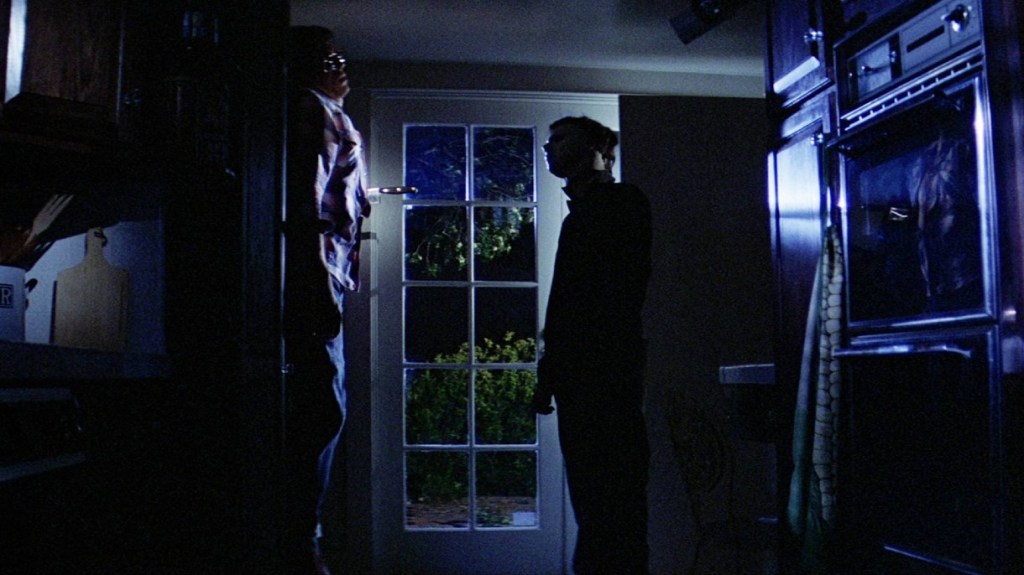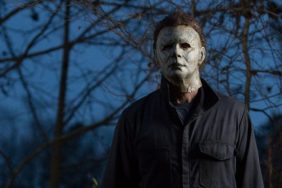45 years ago, John Carpenter hit the kind of paydirt that keeps him in snacks and video games to this very day. There’s really not much left to be said about Halloween‘s impact since its release in 1978. A small-scale yet fleshed-out feature film born from the ideas and visual style of Carpenter’s student short Captain Voyeur. It created a horror icon in Michael Myers and gave the movie world Jamie Lee Curtis, which I think was a pretty good thing.
There’s so much to look at with the original Halloween, and it’s something that gets more fascinating to examine the more sequels, spin-offs, reboots, and requels are added to its legacy.
But for here and now, we’re focusing on the original, and picking our favorite aspects and moments from it in no particular order.
The Opening POV Kill

It’s hardly a surprise anymore, but the first time I watched that opening where a young Michael brutally murders his sister and saw it all from his point of view so that end reveal was a genuine shock. It’s been homaged to the hilt in the years since and it wasn’t exactly original to begin with, but it’s such a beautiful way to give birth to the character of Michael Myers. We establish he’s a stone-cold psychopathic killer from a young age, and that serves you up the delicious question of ”If he was that bad then, what’ll he be like now?”
Donald Pleasence: Monologue Machine

There’s a Mount Rushmore of important things that carry Halloween to greatness, and Donald Pleasance definitely has his face carved out on that rockface. His arrogant, alarmed, and downright maniacal turn as Dr. Loomis acts as Michael Myers’ biggest hype man by seriously scolding anyone who’ll not listen to him about just how dangerous his former patient is.
And I love that it’s not all high drama with Loomis. The scene where he pranks Lonnie on Halloween night shows he’s not afraid to partake in the seasonal festivities, even when staking out the house of a psychopathic killer.
I love Pleasence as an actor, especially his dangerously unhinged role in Wake in Fright, but he’s just as important to Halloween as Michael or Laurie.
The Mood on Halloween Night

Before the waste hits the proverbial fan, there’s something quite cozy about the atmosphere of Halloween Night. Set in a time before decorations were as gaudy and Day-Glo bright as today, there’s an understated, almost ineffectual amount of decoration for the event.
You could say that Michael’s presence blankets the celebration in darkness, but no, darkness is as much a comfort as it is a threat in Halloween. When Tommy Doyle or Lindsey Wallace sit watching movies on TV in the dark, illuminated only by the black and white glow of the screen, it’s an oddly comforting image—a nostalgic feeling for many horror fans who used to revel in that ritual in their youth (and still do).
You’ve Got (No) Red on You

David Gordon Green’s recent trilogy of Halloween films is pretty damn grisly, and it’s a far cry from the almost chaste nature of the original film’s violence. That’s not to say Blood and Guts can’t work in a Halloween movie, but it’s still quite impressive how Carpenter makes it seem like a more violent movie than it actually is. The power of suggestion plays a part, we look in quizzical awe at Michael pinning Bob to the kitchen wall with supernatural ease, but we see very little of what it has done to him.
What little blood there is feels so much more impactful and dramatic, making that finale the classic encounter it is.
Myers Has a Sense of Humor

There’s some great moments of silliness in Halloween that knock back the grave seriousness. Loomis enjoying a Halloween prank after screaming at everyone about how urgent and dangerous the situation is definitely qualifies as one, but another wrinkle in Loomis’ insistence that Michael is nothing more than a cold-blooded killing machine comes after Michael kills Bob and heads up to the bedroom. Laurie’s friend Lyndsey is waiting for her boyfriend, and when a figure looms in the doorway, that’s who she thinks has shown up.
See, Michael put on a sheet and popped poor old Bob’s glasses over the top, so Lynda thinks it’s just Bob playing dress up. It’s almost a masterclass in deadpan humor that Michael even does it as a prelude to murdering Lynda. Especially as his understanding of whatever bit he’s doing extends to strangling Lynda as she’s on the phone with Laurie, who just thinks Lynda and Bob are getting frisky.
Michael Myers can do comedy and horror, just like his Canadian namesake.
He’s Not Dead

It’s quite the cliche at this point, but Michael’s repeated revivals really sell his relentless murder lust. That’s mainly down to how Carpenter frames it. Long before The Undertaker was getting a pop for ”rising from the dead” in a match, Michael had perfected it. The intensity of Laurie’s panicked scrambles as she temporarily staggers Myers, the dread drop of him getting back up time and again, and especially that final escape .
The Haunting of Haddonfield

It’s almost unfortunate we ever had a single sequel to Halloween’s story because the impact of the ending would be so much stronger, having the ambiguity of Laurie’s future after these events and the dread-inducing worry of where Michael had gone and whether he was alive or dead. Either way, you feel that Myers haunts Haddonfield forever.
But that genie is well and truly out of the bottle at this point, so we can only admire the other way he haunts Haddonfield on Halloween. His uncanny ability to be both in plain sight and almost invisible is intriguing. In daylight, he gets to blend in simply because of the date, but come nightfall, he sticks to the shadows and goes full killer. Either way, Michael is always there, always watching, and when night does fall, he’ll kill again. He’s the ghost of a town’s tragic past.










